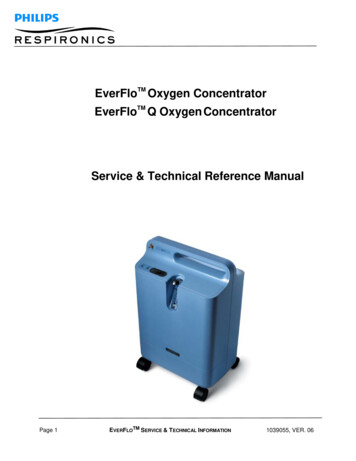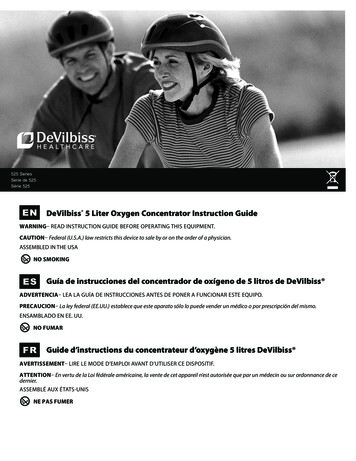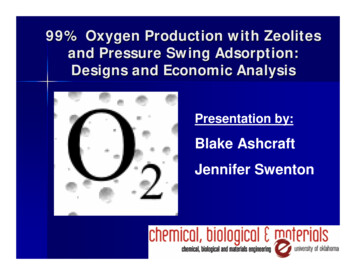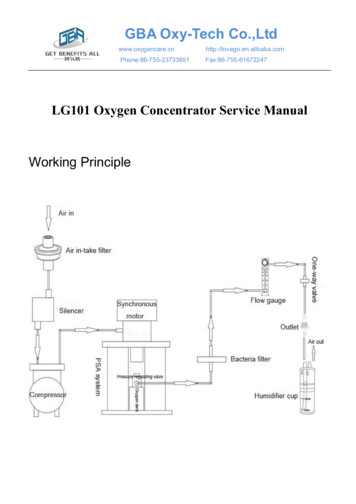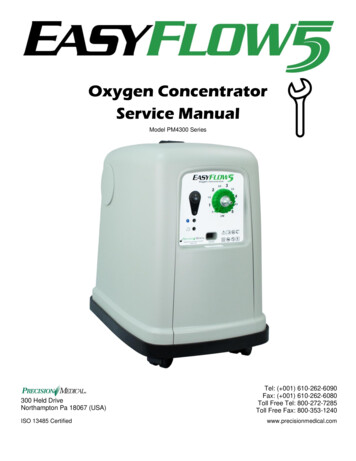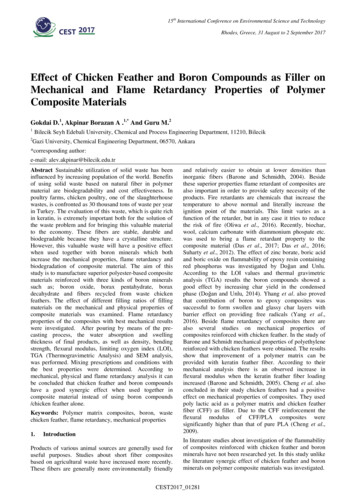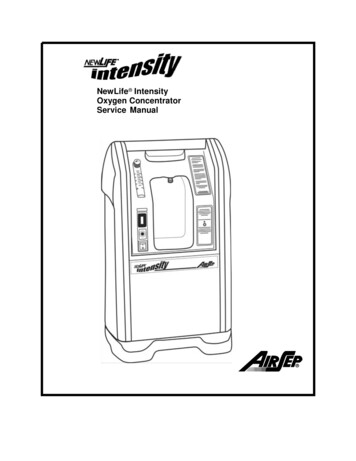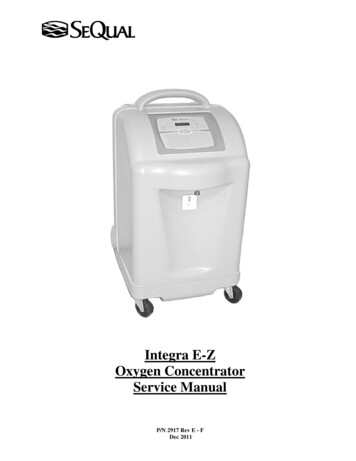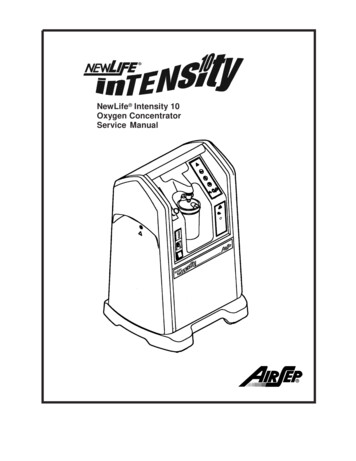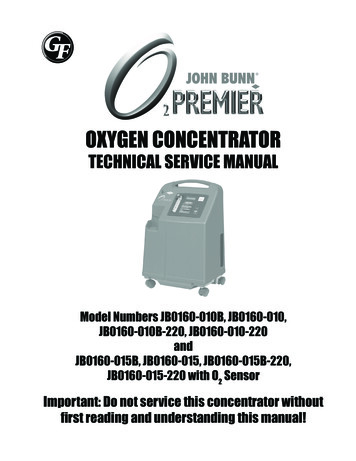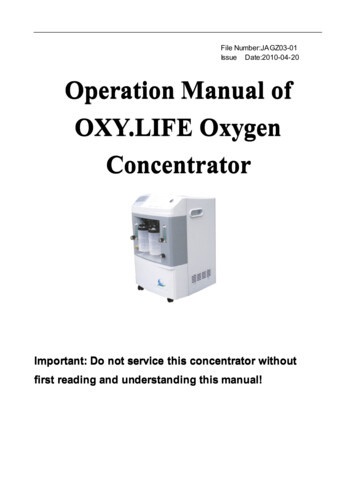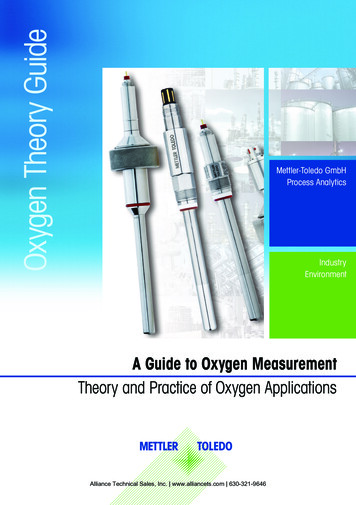
Transcription
Oxygen Theory GuideMettler-Toledo GmbHProcess AnalyticsIndustryEnvironmentA Guide to Oxygen MeasurementTheory and Practice of Oxygen ApplicationsAlliance Technical Sales, Inc. www.alliancets.com 630-321-9646
ContentsNext PagePrevious PagePrintCopyright 2016 by Mettler-Toledo GmbHCH-8902 Urdorf/SwitzerlandAlliance Technical Sales, Inc. www.alliancets.com 630-321-9646Close
ContentsNext PagePrevious PagePrintCloseA Guide to Oxygen MeasurementTheory and Practice of Oxygen ApplicationsAlliance Technical Sales, Inc. www.alliancets.com 630-321-9646
ContentsNext PagePrevious PagePrintAlliance Technical Sales, Inc. www.alliancets.com 630-321-9646Close
ContentsNext PagePrevious PagePrintCloseContents1Theoretical background of oxygen measurements1.1 Physicochemical background of oxygen measurement1.1.1 Units of pressure measurement1.1.2 Dalton’s law on partial pressures1.1.3 Henry’s law for gases dissolved in liquids1.2 Solubility – oxygen concentration1.3. Units for measurement of oxygen concentration1.3.1 Concentration1.3.2 Saturation1010101114151718182Calibration of oxygen sensors2.1 1-point calibration2.2 2-point calibration2.3 General considerations for 2-point calibrations2.4 Process calibration2.5 Process scaling2020212122223Electrochemical methodology3.1 Measurement technology3.2 Parameters determining current3.2.1 Oxygen partial pressure3.2.2 Sensor membranes3.2.3 Polarization voltage3.2.4 Temperature3.2.5 Flow3.3 Design of METTLER TOLEDO amperometricoxygen sensors3.3.1 2-electrodes – for medium to highoxygen concentrations3.3.2 3-electrodes – for medium to highoxygen concentrations3.3.3 2-electrodes with guard ring – for traces of oxygen2323242526282828Alliance Technical Sales, Inc. www.alliancets.com 630-321-964629313233Oxygen Theory GuideMETTLER TOLEDO3
ContentsNext PagePrevious PagePrintClose3.3.4 3-electrodes with guard ring – for traces of oxygen 343.4 Initial start-up and polarization35454Oxygen Theory GuideMETTLER TOLEDOOptical oxygen measurement4.1 Measurement technology4.2 Design of METTLER TOLEDO optical oxygen sensors4.3 Optical sensor calibration4.3.1 Calibration requirements4.4 Optical aging, stability control and calibrationrecommendations4.4.1 Automatic Stability Control (ASC)4.4.2 Recommended calibration frequency4.5 Communication installation options4.5.1 Digital communication4.5.2 Simulated amperometric communication3838414142Common challenges with oxygen measurements5.1 Sensor related factors5.1.1 Amperometric sensors5.1.2 Optical sensors – OptoCap wear and damage5.2 Media related factors5.2.1 Amperometric sensors5.2.2 Optical sensors5.3 External related factors5.3.1 Trapped air5.3.2 Biological growth5.3.3 Varying system pressure5.3.4 Amperometric sensors: fluctuating flow5.4 Other factors5.5 Sensor maintenance: amperometric sensors5.5.1 Nominal sensor current in airflow5.5.2 Nominal zero point current in nitrogen5.5.3 Response testing5.5.4 Maintenance: Changing the electrolyte andmembrane body5.5.5 In situ lliance Technical Sales, Inc. www.alliancets.com 630-321-96464545474949496060
Contents67Next PagePrevious PagePrintClose5.6 Sensor maintenance: optical sensors5.6.1 Response testing6162Intelligent Sensor Management (ISM)6.1 Signal integrity6.2 Pre-calibration6.3 Predictive diagnostics6.4 ISM algorithms in more detail6.4.1 Dynamic Lifetime Indicator6.4.2 Adaptive Calibration Timer6.4.3 Time to Maintenance – for amperometric sensors6.4.4 Total Operation of OptoCap (tooCap)– for optical sensors6.4.5 Calibration history6.4.6 Control – for optical sensors6.5 Asset management software6.5.1 Calibration6.5.2 Electronic documentation6.5.3 Sensor management6464656567676868Comparison of optical and amperometric technologies7.1 Application in breweries7.2 Application in the pharmaceutical industry7.3 Application in the power industry74747677Alliance Technical Sales, Inc. www.alliancets.com 630-321-964669696970717173Oxygen Theory GuideMETTLER TOLEDO5
ContentsNext PagePrevious PagePrintCloseTablesTable 1Table 2Table 3Table 4Table 5Table 6Table 7Table 8Table 9Table 10Table 11Table 12Table 13Table 14Table 156Oxygen Theory GuideMETTLER TOLEDOUnits for pressure and calculation from Pascal (SI unit)to other unitsVapor pressure for 100 % relative humidity at differenttemperaturesSolubility of oxygen in different media at 20 ºC and1013 mbar; 100 % saturationCorrelation of concentration and 100 % air saturationat different temperatures in water; pressure is normalpressure with 1013 mbarParameters which influence the amount of currentbetween anode and cathodeDesign of METTLER TOLEDO oxygen sensorsfor dissolved oxygenDesign of METTLER TOLEDO oxygen sensorsfor gas phaseChemical reactions in different METTLER TOLEDOamperometric sensor designsIdeal polarization time according to depolarization timeSensor status of different METTLER TOLEDOoptical oxygen sensors as shown in iSense(KSV: Stern-Volmer constant)Recommended calibration procedures forMETTLER TOLEDO optical oxygen sensors;“high“ means in ppm range, “low“ means in ppb rangeSensor related factors, which influence oxygenmeasurementsInterference of different chemical substances withamperometric sensorsNominal Sensor Current in Airflow [NSCiA] in nA at1013 mbar (hPa) and 25 CZero current in different METTLER TOLEDO sensorsat different time intervalsAlliance Technical Sales, Inc. www.alliancets.com 630-321-9646101316192529303537444850545859
ContentsNext PagePrevious PagePrintCloseFiguresFigure 1Figure 2Figure 3Figure 4Figure 5Figure 6Figure 7Figure 8Figure 9Figure 10Figure 11Figure 12Figure 13Figure 14Figure 15Figure 16Figure 17Figure 18Figure 19Figure 20Figure 21Figure 22Gaseous composition of dry air11Influence of air pressure on partial pressures12Partial pressures of oxygen in dry air and humid air witha vapor pressure (water) of 31.7 mbar (hPa) (pwsat)14Henry’s law – the concentration of oxygen in the liquidis proportional to the partial pressure of the oxygen inthe gaseous phase surrounding the liquid15Oxygen solubility in pure water is dependent on temperature 16Cross section of a Clark-type oxygen sensor24S-type membrane used in METTLER TOLEDOamperometric oxygen sensors27T-type membrane used in METTLER TOLEDOamperometric oxygen sensors27Schematic overview of a 2-electrodeamperometric sensor31Examples of 2-electrode sensors InPro 6050 (above)and InPro 680031Schematic overview of a 3-electrodeamperometric sensor32Example of a 3-electrode sensor (InPro 6850 i)32Schematic overview of a 2-electrodeamperometric sensor with guard ring33Example of a 2-electrode amperometric sensorwith guard ring (Thornton ISM DO sensor)33Schematic overview of a 3-electrode amperometricoxygen sensor with guard ring34Example of a 3-electrode amperometric oxygen sensorwith guard ring (InPro 6950 i)34Polarized oxygen-free zone36Steps of fluorescence and fluorescence quenching38Phi measurements at high and low oxygen concentrations 40Optical sensor cross-section example41Example of an oxygen calibration curve with opticaloxygen sensors42Example of process scaling43Alliance Technical Sales, Inc. www.alliancets.com 630-321-9646Oxygen Theory GuideMETTLER TOLEDO7
ContentsNext PagePrevious PagePrintCloseFigure 23 Phi 0 and Phi 100 shifts and the effect of calibrationFigure 24 Calibration adjustments without and with AutomaticStability ControlFigure 25 Cracked and delaminated anode / cathodeFigure 26 Membrane tearFigure 27 OptoCap fluorophore examplesFigure 28 Impact of air bubbles and biological growth onan amperometric DO sensorFigure 29 Impact of air bubbles and biological growth onan optical DO sensorFigure 30 Response testing examplesFigure 31 Typical sensor signal examples for troubleshootingamperometric oxygen sensorsFigure 32 Typical sensor signal examples for troubleshootingoptical oxygen sensorsFigure 33 Sensor with ISM chip in sensor headFigure 34 Calibration protocol of an optical sensor with iSense464751525356566061636472EquationsEquation 1 SI unit Pa of pressureEquation 2 Dalton’s law for the composition of airEquation 3 Calculation of oxygen partial pressure in a humidenvironmentEquation 4 Henry’s law of gases dissolved in liquidsEquation 5 Conversion of partial pressure to concentration ofdissolved oxygenEquation 6 Derivation of Fick’s law shows that the current is mainlydependent on the nature of the membraneEquation 7 Stern-Volmer relation8Oxygen Theory GuideMETTLER TOLEDOAlliance Technical Sales, Inc. www.alliancets.com 630-321-964610111315162440
ContentsNext PagePrevious PagePrintCloseOxygen Theory GuideOxygen measurement and control plays an important role in manychemical, pharmaceutical, biotechnology, power, and food & beverageprocesses. In fermentation, oxygen control leads to increased yield anddecreased production of unwanted byproducts. Oxygen management inthe chemical industry helps to avoid the formation of explosive gas mixtures, and oxidation control in the brewing industry results in increasedquality and shelf life of end products. The in-line measurement of oxygenin liquid and gaseous mixtures is vital in these and countless other processes for providing continuous, real-time data on oxygen levels.Today, there are many electrochemical and optical technologies available for the measurement of oxygen in both aqueous and gas phasemedia. METTLER TOLEDO offers three such technologies; amperometric, optical and laser spectroscopy. Amperometric technology has been successfully used for decades ina variety of applications and is based on electrochemical reactions. Optical technology is relatively new but has gained wide acceptancein the biotech and beverage industries. Its measurement principleexploits the phenomenon of fluorescence quenching. The newest technology offered by METTLER TOLEDO for determination of gaseous oxygen and other gases, is tunable diode laser(TDL) spectroscopy. TDL is also an optical method and is based onlight absorption.This booklet provides an overview of oxygen measurement theories,an explanation of amperometric and optical sensor technologies, andan introduction to the benefits of the Intelligent Sensor Management(ISM ). For information on tunable diode laser spectroscopy, pleaserefer to the TDL theory guide available at www.mt.com/O2-gas.Alliance Technical Sales, Inc. www.alliancets.com 630-321-9646Oxygen Theory GuideMETTLER TOLEDO9
Oxygen Theory GuideContentsNext PagePrevious PagePrintClose1Theoretical background of oxygenmeasurements1.1Physicochemical background of oxygen measurementOxygen typically is encountered as a gas. Therefore, the in-line andon-line measurement of oxygen in processes is a measurement of thepressure which the oxygen applies either in the gas or in the liquid inwhich it is dissolved. Depending on the kind of application and also onthe habits of a certain industry, the oxygen concentration is expressedeither in relative numbers, such as percent saturation, volume percent,percent oxygen, ppm or in absolute numbers, e.g., mg/L or mmol/L.1.1.1Units of pressure measurementThe SI unit (International system of units) of pressure is the Pascal(Equation 1). There are also other units commonly used, especially inmedicine and technological processes, such as mmHg (Torr), bar andatm. The following table (Table 1) gives the calculations from one unitto another.1 Pa 1N 1m2kgm s2Equation 1 SI unit Pa of pressurePascalBarN / m2Mdyn / cm21 Pa11 bar1.0000 · 1051 at1.0000 ·9.8067 ·1041 atm 1.0133 · 1051 Torr 1.3332 ·1 psiTable 110Oxygen Theory GuideMETTLER TOLEDO1026.8948 · 10310 –519.8067 ·PhysicalAtmosphereTorrkp / cm2pSTPmmHg1.0197 ·10 –51.019710 –11.01331.3332 ·TechnicalAtmosphere16.8948 · 10 –21.3595 ·7.5006 · 10210 –17.3556 · 1027.6000 · 102110 –37.0307 · 10 –27.5006 · 10 –39.8692 · 10 –19.6784 ·1.033210 –39.8692 ·10 –61.3158 ·10 –36.8046 · 10 –215.1715 · 101Units for pressure and calculation from Pascal (SI unit) to other unitsAlliance Technical Sales, Inc. www.alliancets.com 630-321-9646
ContentsNext PagePrevious PagePrintCloseSince the measurement is dependent on the pressure of the oxygen,there are two particular physicochemical laws concerning pressure thatare central to oxygen measurement: Dalton’s law on partial pressures for oxygen in gaseous and liquidphases and Henry’s law on gas solubility in liquids for measurements of oxygendissolved in liquids.1.1.2Dalton’s law on partial pressuresDalton’s law states that, in ideal gases, the total pressure of a gasmixture is equal to the sum of the partial pressures of the individualgases. Air consists of nitrogen, oxygen, carbon dioxide and argon andother precious gases. According to Dalton’s law, the pressure of air isthe sum of the partial pressures of the individual gases:Pair pnitrogen poxygen pcarbon dioxide pprecious gasesEquation 2Dalton’s law for the composition of airFigure 1 below shows the gaseous composition of dry air in volumepercent. Oxygen contributes about 21 % to the total pressure of a givenvolume of air. If at an atmospheric pressure of 1013 mbar (hPa), 21 %of this pressure is contributed by oxygen, the so called partial pressureof oxygen (pO2 ).In dry air it is 212 mbar (hPa) according to Dalton’s law.78.0920.950.930.03Figure 1vol % Nitrogenvol % Oxygenvol % Argonvol % Carbon dioxideGaseous composition of dry airAlliance Technical Sales, Inc. www.alliancets.com 630-321-9646Oxygen Theory GuideMETTLER TOLEDO11
ContentsNext PagePrevious PagePrintCloseOxygen Theory GuideAs shown in Figure 2 below, if total pressure on this system is doubledto 2026 mbar (hPa), the partial pressure also doubles to 424 mbar(hPa). The relative volume percent of oxygen remains 21 %. However,the transmitter would display a two-fold increase in the oxygen value inpercent since the sensor is only responding to the partial pressure ofoxygen. For this reason, it is extremely important that oxygen measurement equipment corrects for system pressure in order that accuratemeasurements can be made when measuring in relative units.Please note that this calculation is only valid for volume percent.If mass percentages are used as the output, the concentration has tobe calculated via the partial pressure and the mole fractions.Air pA 1013 mbarp sum 1013 mbarAir pA 2026 mbarpO2 424 mbarp sum 2026 mbar212 mbar 21% O21013 mbarFigure 2pO2 212 mbar424 mbar 21%2026 mbarInfluence of air pressure on partial pressuresBased on Henry’s law, partial pressure influences relative oxygen measurements in systems that contain compressed gases in headspacesof monitored vessels. Closed systems completely filled with liquid donot require compensation for system pressures.Note: The sensor measures partial pressures.1.1.2.1 Influence of humidityRelative humidity is the proportion of humidity relative to a water saturated gas mixture at a specific temperature. It can vary from 0 to 100 %.The partial pressure of this humidity or the so called vapor pressure is– as all partial pressures – temperature dependent (Table 2, p. 13).12Oxygen Theory GuideMETTLER TOLEDOAlliance Technical Sales, Inc. www.alliancets.com 630-321-9646
ContentsNext PagePrevious PagePrintT [ C]ClosepH 0 (sat) 199.270311.680473.4907021001013Table 2Vapor pressure for 100 % relative humidity at different temperaturesFor calculating the partial pressure of oxygen in percent saturation ina gas mixture, the vapor pressure of water and the ambient pressure(process pressure) need to be considered (see Equation 3 below,Figure 3 / p. 14).pO2 xO2 · (pair pH2O )pO2 Oxygen partial pressurexO2 Mole fraction of oxygenpair Atmospheric pressurepH2O Vapor pressureEquation 3 Calculation of oxygen partial pressure in a humid environmentAlliance Technical Sales, Inc. www.alliancets.com 630-321-9646Oxygen Theory GuideMETTLER TOLEDO13
Oxygen Theory GuideContentsNext PagePrevious PagePrintCloseAtmospheric pressure (1013 mbar, 25 C)Dry airHumid air31.7 mbarWaterNitrogenNitrogen212.2 mbarOxygenCO2 / ArgonFigure 3205.6 mbarOxygenCO2 / ArgonPartial pressures of oxygen in dry air and humid air with a vapor pressure(water) of 31.7 mbar (hPa) (pwsat)Note: It is extremely important to correct for system pressure andhumidity when calibrating the sensors on relative units like percentsaturation or percent oxygen.1.1.3Henry’s law for gases dissolved in liquidsWhen working with process liquids, the oxygen to be determined isnormally dissolved in these liquids. This dissolved oxygen is in asteady-state or equilibrium with the oxygen in the ambient gas phase.The physical relationship is described by Henry’s law. It states that thepartial pressure of a gas above a liquid is directly proportional to theconcentration of that gas dissolved in the liquid (see Figure 4, p. 15).This means that the concentration of dissolved oxygen can be measured by comparing the partial pressure of the dissolved oxygen to thepartial pressure of the oxygen in the surrounding gas phase.The concentration is determined by the Henry constant.14Oxygen Theory GuideMETTLER TOLEDOAlliance Technical Sales, Inc. www.alliancets.com 630-321-9646
ContentsNext PagePrevious PagePrintClosePartial pressureO2 in airEquilibriumPartial pressureO2 in liquidFigure 4Henry’s law – the concentration of oxygen in the liquid is proportional to thepartial pressure of the oxygen in the gaseous phase surrounding the liquidcO2 a · pO2cO2 oxygen concentration in the solutiona Henry constantpO2 partial pressure of oxygenEquation 4 Henry’s law of gases dissolved in liquidsThe Henry constant is dependent on the liquid, in which the gas is dissolved, as well as on the temperature, because these factors influencethe solubility of oxygen (see Chapter 1.2).1.2Solubility – oxygen concentrationGases are soluble in liquid to varying degrees.Solubility of a gas in a liquid is a function of– The temperature – the higher the temperature the lower the solubility(see Figure 5, p. 16)– The salinity – increasing salinity leads to a reduced solubility of oxygen– The solution itself (see Table 3, p. 16)Alliance Technical Sales, Inc. www.alliancets.com 630-321-9646Oxygen Theory GuideMETTLER TOLEDO15
Oxygen Theory GuideContentsNext PagePrevious PagePrintCloseConcentration15of oxygen [mg/L]14131211109876502040Temperature [ºC]Figure 5Oxygen solubility in pure water is dependent on temperatureThis solubility, expressed as a mole fraction, is proportional to thepartial pressure of the gas over the liquid (Henry’s law).Type of liquidSolubility of oxygen at 20 C and 1013 mbarPure water9.1 mg / L4 M KCl2.0 mg / L50 % Methanol / 50 % water21.9 mg / LTable 3Solubility of oxygen in different media at 20 ºC and 1013 mbar; 100 %saturationAs mentioned, according to Henry’s law the oxygen concentration isproportional to its partial pressure (pO2 ).c O2 p O2 · aa solubility factor, Henry constantEquation 5 Conversion of partial pressure to concentration of dissolved oxygen16Oxygen Theory GuideMETTLER TOLEDOAlliance Technical Sales, Inc. www.alliancets.com 630-321-9646
ContentsNext PagePrevious PagePrintCloseIf “a“ is constant, the oxygen concentration can be determined bymeans of a sensor.This means that in media with constant temperature and constant solutions the oxygen concentration can be determined. If the nature ofsolution changes, a new calibration to this solution has to be done.Although the solubility may vary widely (see Table 3, p. 16), the resulting relative dissolved oxygen measurement as partial pressure from asensor will be the same in all solutions. Therefore, determination of theabsolute oxygen concentration is only possible with constant andknown solubility factors “a“. Transmitters only show the solubility factorfor water. Solubility tables and corrections for different pressures andsalt contents can be found on the website of the USGS.(http://water.
METTLER TOLEDO 3.3.4 3-electrodes with guard ring – for traces of oxygen 34 3.4 Initial start-up and polarization 35 4 Optical oxygen measurement 38 4.1 Measurement technology 38 4.2 Design of METTLER TOLED
